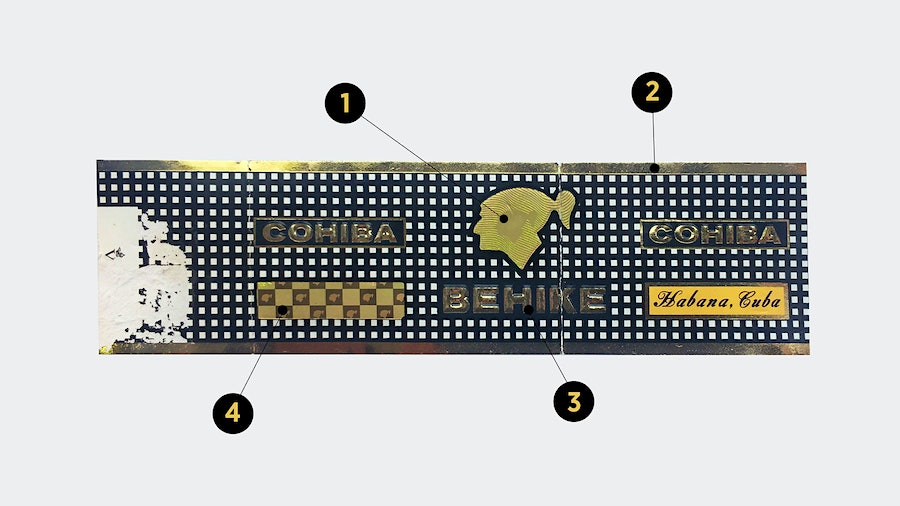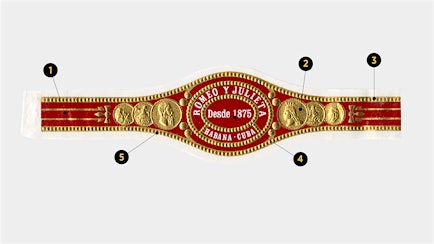How To Spot A Fake Cohiba Behike BHK

When Cuba launched the Cohiba Behike BHK line in 2010, it instantly captivated cigar connoisseurs around the world. The new smoke won critical acclaim as well as commercial success, and the Cohiba Behike BHK 52 was named Cigar Aficionado’s 2010 Cigar of the Year.
Given its success, it’s no surprise that Cohiba Behike became one of the most counterfeited brands in the world shortly after it was released. If you know what to look for, though, you will be able to protect yourself from being swindled.
Cohiba Behike is a three-vitola line comprised of the BHK 52, which is the smallest at 4 3/4 inches by 52 ring gauge; the BHK 54, 5 3/4 inches long by 54 ring, and BHK 56, 6 1/2 by 56. Connoisseurs may recall that Habanos released a cigar in 2006 as part of a special 40th anniversary humidor that was called Cohiba Behike. Only 4,000 Cohiba Behikes were released then, at a price of $400 or more per cigar. Those cigars wore the old Cohiba Behike band, with a secondary band reading Behike. It’s unlikely, however, that you will run into one in the wild.
The Cohiba Behike BHK blend includes a bit of medio tiempo tobacco, which is a flavorful, but rarely seen on a tobacco plant. Given the low yield of medio tiempo, Cohiba Behike BHK is a rare cigar to see on store shelves in today’s marketplace. In other words, you aren’t likely to see a genuine BHK being sold outside of a licensed Habano dealer. You won’t find a BHK being sold on some tropical beach for $10.
Forgers have found it difficult to mimic the Cohiba Behike BHK’s elaborate packaging. Each size comes in boxes of 10 that are coated in a luxuriously thick, high-gloss piano lacquer, with gold highlights and squares that have a blue-gray hue. If someone approaches you with a box of Behikes and it’s anything but a box of 10, they are fake.
The lids are solid without ridges or collars and do not have brooches. Inner hinges are branded with the words “Cohiba” and the bottom of each box has a smooth swath of felt rather than an exposed wood grain common to other brands. If any of these elements are absent, don’t buy the cigars.
The glossy box also comes inside a felt covering, which is then put inside a black cardboard box containing the Habanos sticker and the Cuban guarantee seal. (Watch this video to see a genuine Behike box next to a fake one.)
When the Cohiba Behike BHK first came out, the band alone was a technological innovation for the cigar market. Full of complex impressions and intricate trim, the bands were encoded with holographic emblems put in place for the sole reason of thwarting fakes. This pioneering security effort marked the first time that 3-D type images appeared on Cuban cigar bands. Not only did the gilded bands have a glittering “wow” factor for consumers, but the advanced design made unauthorized reproduction difficult in a way that forgers and knock-off artists had never seen.
In 2014, Habanos began adorning Cohiba Behike BHKs with a new holographic band. The new label incorporates even more complex imagery than the old, making it markedly difficult for counterfeiters to duplicate.
While the overall composition of the new Behike bands remains the same, the primary difference is the security strip on the back, which has a redesigned and modernized repeating holographic pattern. The pattern still consists of Cohiba’s trademark Indian head profile and the Behike insignia, though its arrangement has changed.
Here are the elements of the Cohiba Behike BHK band that you should look for to decide if it’s authentic or not:
1) Holographic Taino Indian Head
Front and center on the band is a holographic image of the famous Taino Indian head. Look closer and you will see that there, in fact, there is a smaller head within the larger. This “head-within-head” effect is a telling sign that the band is authentic.
2) Holographic Elements
Holograms of the word “Cuba” and the Taino Indian head repeat on the gilded top edge of the band.
3) Nine White Squares
Nine rows of white squares in a checkered pattern run from the gilded top edge to the top of the word "Behike." It’s important to note that the squares are full and do not get cut off either on the top or bottom row.
4) Repeating Logos, Checkerboard Pattern
Holographic Taino Indian head logos and boxes containing the words "Behike" and "Cohiba" repeat in this gold foil box to create a checkerboard pattern.
5) Embossed Lettering
The famous Cohiba on white background with a square, gold border is embossed with proper gilding. However, it is non-holographic.
Submit A Fake
Think you may have purchased or smoked a fake Cuban cigar? Let us be the judge. Send any questionable Cuban band(s), along with a brief description of how/where you obtained the cigar(s), to our office address below. Due to the high volume of mail we receive, a response isn't guaranteed.
Cigar Aficionado
c/o Counterfeit Cigars
825 8th Avenue, 33rd Floor
New York, NY 10019





